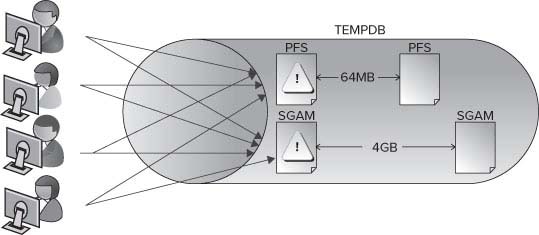Compared to a normal database, tempdb’s use as a temporary storage area makes the workload pattern likely to contain a disproportionate amount of the creation and destruction of many small objects. This type of workload can lead to latch contention on the pages required to allocate objects in a database.
A latch is a short-term synchronization lock used by SQL Server to protect physical pages — it’s covered only briefly here for the sake of context.
You can’t influence latching behavior by changing the isolation level or by using “hints,” as you can with normal locks; latches are used automatically behind the scenes to protect pages in memory from being modified by another task while the content or structure is being changed or read from disk.
Allocation Pages
When you create an object such as a temporary table in tempdb, it needs to be allocated space in exactly the same way as creating a table in a normal database. You need to be aware of three pages in the allocation process: Page Free Space, Global Allocation Map, and Shared Global Allocation Map, all of which are covered in the following sections.
PFS (Page Free Space)
The PFS page stores 1 byte of information for each page, indicating how much free space is on it and what it’s used for, which means that a single PFS page can store information about roughly 64MB of pages. Therefore, you’ll find a new PFS page at close to 64MB intervals throughout a database data file.
The first page on any database data file is always a PFS page, so it’s easy to spot the page in an error message. If you see “2:1:1” anywhere, it’s referring to the first page on the first data file in database_id 2, which is tempdb; “5:3:1” would be the first PFS page in file_id 3 in database_id 5.
GAM (Global Allocation Map)
The GAM page tracks 1 bit per extent (an extent is eight pages), indicating which extents are in use and which are empty. SQL Server reads the page to find free space to allocate a full extent to an object.
Storing only 1 bit for each extent (instead of 1 byte per page like the PFS page) means that a single GAM page can track a lot more space, and you’ll find a new GAM page at roughly 4GB intervals in a data file. However, the first GAM page in a data file is always page number 2, so “2:1:2” would refer to the first GAM page in tempdb.
SGAM (Shared Global Allocation Map)
The SGAM page (pronounced ess-gam) also stores 1 bit per extent but the values represent whether the extent is a mixed extent with free space or a full extent. SQL Server reads this page to find a mixed extent with free space to allocate space to a small object.
A single SGAM can track 4GB of pages, so you’ll find them at 4GB intervals just like GAM pages. The first SGAM page in a data file is page 3, so “2:1:3” is tempdb’s first SGAM page.
Allocation Page Contention
Imagine that you take an action within an application that needs to create a temporary table. To determine where in tempdb to create your table, SQL Server will read the SGAM page (2:1:3) to find a mixed extent with free space to allocate to the table.
SQL Server takes out an exclusive latch on the SGAM page while it’s updating the page and then moves on to read the PFS page to find a free page within the extent to allocate to the object.
An exclusive latch will also be taken out on the PFS page to ensure that no one else can allocate the same data page, which is then released when the update is complete.
This is quite a simple process (but maybe not to explain) and it works very well until tempdb becomes overloaded with allocation requests. The threshold can be hard to predict and the next section describes several things you can do to proactively avoid it.
The issue itself manifests as a PAGELATCH wait, with 2:1:1 or 2:1:3 as the resource description. Figure 1 shows contention on the allocation pages because multiple users are trying to allocate many objects at the same time.

Figure 1.
Leave a Reply